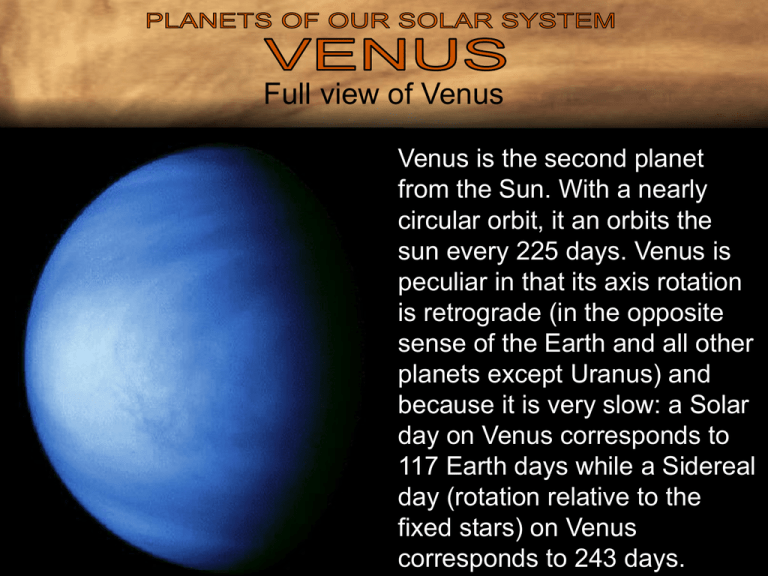The surface of Venus is rather smooth in many places, though not
advertisement

Full view of Venus Venus is the second planet from the Sun. With a nearly circular orbit, it an orbits the sun every 225 days. Venus is peculiar in that its axis rotation is retrograde (in the opposite sense of the Earth and all other planets except Uranus) and because it is very slow: a Solar day on Venus corresponds to 117 Earth days while a Sidereal day (rotation relative to the fixed stars) on Venus corresponds to 243 days. Surface of Venus In the background is Gula Mons, a 1.86 mile high volcano. The impact crater Cunitz, named for the astronomer and mathematician Maria Cunitz, is visible in the center of the image. The crater is 30 miles in diameter. The digital elevation map is used to enhance smallscale structure. Interior of Venus This rendering shows a cutaway view of the possible internal structure of Venus. The image used for the outer atmospheric layer was created from 10 images taken by the Mariner spacecraft. Atmosphere of Venus The atmosphere of Venus is composed of about 96% carbon dioxide, with most of the remainder being nitrogen. The atmosphere appears to be relatively clear until the cloud deck starts about 50 km above the surface. The clouds are composed of sulphuric acid and various other corrosive compounds, and the atmosphere contains little water. Atmosphere of Venus The pressure of the atmosphere is about 90 times that of the Earth at the surface, and the surface temperatures on Venus are around 500 degrees Celsius, exceeding that of Mercury and hot enough to melt soft metals. Calculations indicate that for the temperatures to be so high there must be a mechanism in the Venusian atmosphere that traps solar radiation very effectively. Atmosphere and surface of Venus There are high-velocity winds in the upper atmosphere, but the atmosphere below the cloud deck appears to be relatively stagnant, with only very weak winds blowing at the surface. Convection driven by differential solar heating should give rise to winds of only a few meters per second, so the high velocity upper level winds, and the contrasting stagnation of the lower atmosphere, are not well understood. Atmosphere and surface of Venus The surface of Venus is rather smooth in many places, though not nearly as smooth as originally expected. However, we find evidence for some of the same geological features found on Earth: canyons, volcanoes, lava flows, rift valleys, mountains, craters, and plains. Venus Mythology Venus is named after the Roman goddess of love and beauty. The planet was so named because it was the brightest of the planets known to the ancients. Venus is commonly called the “evening star” or the “morning star” (depending on which side of the sun it happens to be on). It is considered the brightest and most beautiful object in the heavens next to the sun and moon, and is far brighter than any star. Originally the Greeks thought Venus was two different planets. Venus Express Artist's impression of Venus Express. The Venus Express was launched on October 26, 2005. After a six month cruise to Venus the spacecraft will enter the orbit of Venus in April 2006, where it will spend the next 500 days investigating the atmosphere of Venus. Volcano on Venus Computer generated 3-D view of Sif Mons volcano, Venus.







